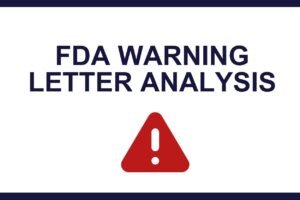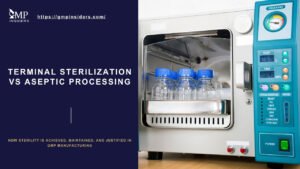Out of specification (OOS) results can be a serious cause for concern in pharmaceutical QC laboratories for various reasons. When test results fall outside the defined acceptance criteria, it raises questions about the root cause that has put the quality and reliability of the tested product in question. These results can occur in various stages, such as raw material testing, in-process testing or final product testing.
This article covers the entire OOS process through the phases of OOS investigations, exploring its impact, the root causes and consequences of OOS results, and the strategies to prevent and address OOS situations. By understanding how to evaluate OOS results and implement effective measures, companies can maintain product quality, safeguard consumer health, and comply with regulatory requirements.
What Are OOS Results?
Out of specification (OOS) results occur when test results fall outside the predefined acceptance criteria or specifications of the testing product. These specifications are established based on the desired quality attributes of a product and serve as benchmarks for assessing its safety, efficacy, quality, and performance. They might indicate a potential deviation from these quality standards, raising concerns about product quality, consistency, and reliability.
The significance of OOS results cannot be overstated. They can have severe implications for both the manufacturer and the end consumer. OOS results may indicate manufacturing errors, equipment malfunctions, contamination, or other issues that compromise the integrity of the product. Identifying and addressing OOS results is crucial to prevent the distribution of substandard or potentially harmful products.
It’s also worth noting other types of results, such as Out of Trend (OOT) results. While OOS results indicate a clear failure to meet predefined criteria, OOT results occur when data remains within specifications but shows an unexpected trend. Monitoring OOT results is important for identifying potential issues early, as they can signal variability that might eventually lead to an OOS result.
Importance of OOS Results in Quality Control
OOS results play a critical role in quality control as they act as an early warning for potential quality issues in the tested product. By promptly identifying and addressing OOS results, pharmaceutical companies can prevent the release of faulty or substandard products, safeguarding consumer safety and satisfaction. OOS results also provide valuable insights into the effectiveness of the organization’s quality control measures, highlighting areas that require improvement.
OOS and Regulatory Compliance
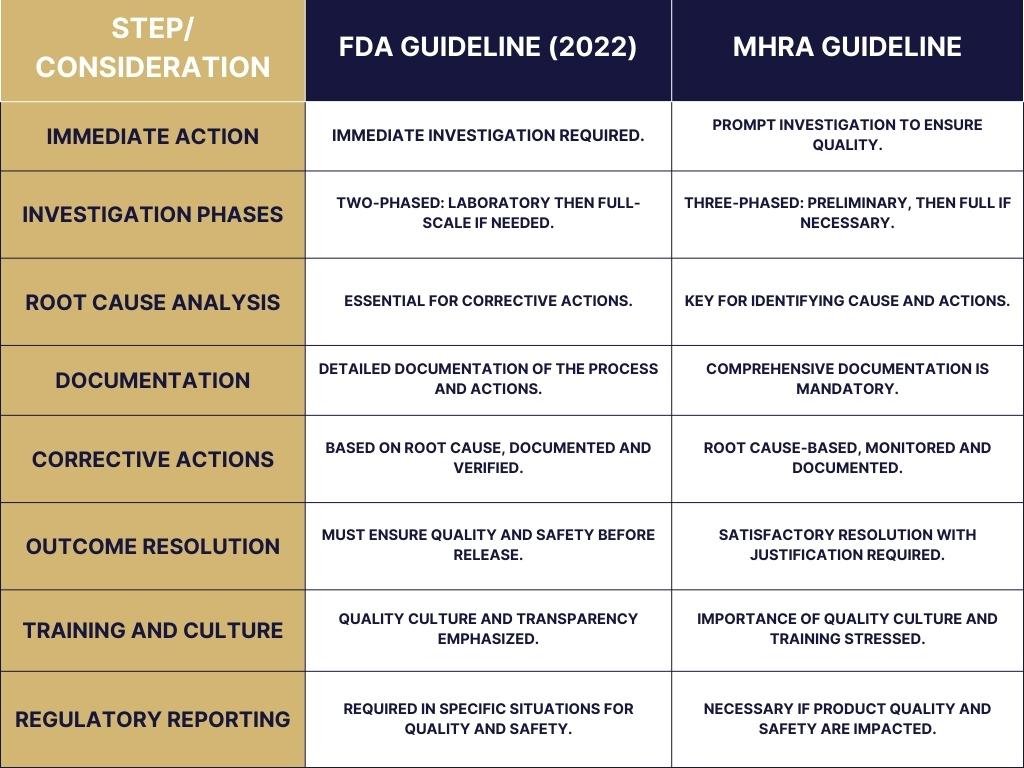
OOS results are closely linked to regulatory compliance. Regulatory bodies, such as the Food and Drug Administration (FDA) or Medicines and Healthcare products Regulatory Agency (MHRA), have general recommendations on how companies should handle OOS results based on individual requirements. Failure to address OOS results and comply with these guidelines may result in regulatory action, including fines, product recalls, and even the suspension of manufacturing operations.
Investigation Process for OOS Results

The acceptance criteria for testing products are established in official compendia, approved marketing submissions, or internal specifications. Any laboratory personnel who will identify a result outside the acceptance criteria must immediately notify their supervisor of a possible OOS result in the laboratory. After this, the supervisor is obligated to initiate the OOS investigation.
One OOS investigation consists of a couple of phases (Phase I, Phase II and Phase III), but it is of utmost importance to understand what these phases consist of and what they can offer to promptly identify the root cause of the emerged OOS result.
Phase la Investigation: Assessing Obvious Errors

Every OOS investigation should start with a Phase Ia laboratory investigation, a critical initial step in addressing OOS results which focuses on an immediate and thorough review of all laboratory operations that might have caused a clear and obvious laboratory error. For a successful Phase Ia investigation, the analyst who reported the OOS result should have all their work (receiving documents, prepared solutions, instrument records/data, calculations, etc.) available for review.
The supervisor should then interview the analyst who reported the OOS result and begin the investigation by addressing the possible errors that might have occurred during the analysis.
If an obvious laboratory error is identified and confirmed during this phase as a root cause, the OOS results should be annulled, and retesting to be initiated. All results that will be acquired from the retesting, should be considered as final results.
If no root cause is identified in Phase 1a, the investigation continues with Phase 1b.
Phase Ia Questionnaire (Checklist)
Having a questionnaire consisting of common laboratory scenarios that have proven to be a reason for a laboratory incident leading to OOS results comes in handy in the initial Phase 1a of an OOS investigation. What will be included in this document depends on every laboratory’s nature and work scope.
Here are some examples of what laboratories usually include in their Phase 1a questionnaires:
- Sampling records and sample handling
- System suitability records
- Samples preparation (Weighing/dilution/mechanical treatment/filtering)
- Equipment functionality (Calibration/Qualification date/Errors log/Visual inconsistencies)
- Analyst’s understanding of the analytical procedure
The main goal of this approach is to help and navigate the analyst and the interviewer (supervisor) through the possible lab error scenarios that might have caused the OOS result.
Pro Tip: Laboratories that will put effort into creating a comprehensive Phase 1a questionnaire will save enormous time on OOS investigations that have entered Phases II and III, where the root cause was an obvious lab error.
Key Aspects of Phase Ia
- Immediate Notification: The analyst who identified the OOS result must immediately notify their supervisor.
- Preliminary Assessment Questionnaire: A preliminary assessment using a thorough questionnaire (checklist) is recommended to review the activities and decide if the root cause is an obvious lab error.
- Analyst’s honesty and thoroughness: The analyst who reported the OOS result must be honest and thorough when filling in the Phase 1a questionnaire and discussing all the steps in detail with his supervisor.
Phase Ib Investigation: Identifying Assignable Causes
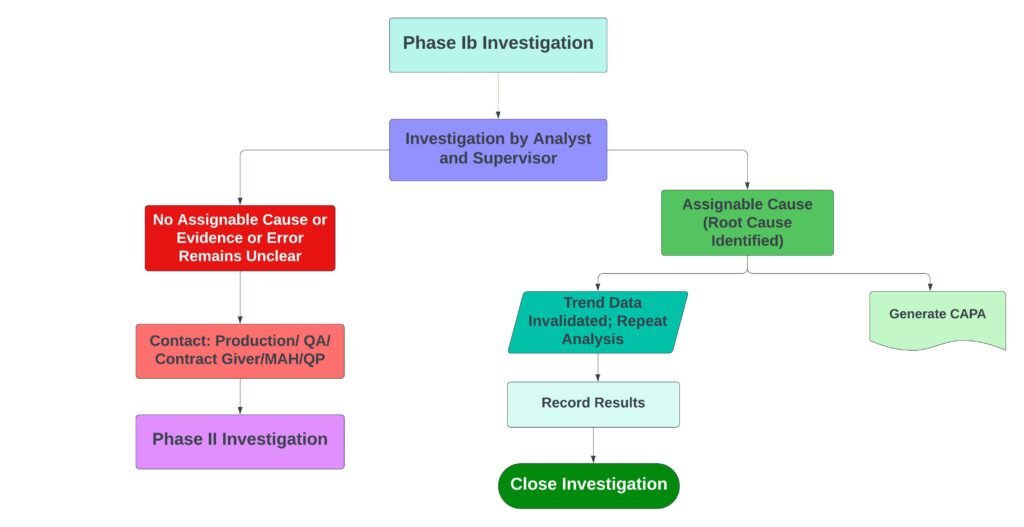
In the absence of a clear and obvious lab error, the OOS investigation continues into Phase 1b, where the supervisor will need to investigate the scene by thoroughly reviewing laboratory notebooks, sample/reagents preparations, instrument records, etc. This will allow the supervisor and the analyst to discuss and investigate all the possible aspects that might not have been covered with the questionnaire in Phase 1a.
If the root cause is identified and confirmed by the supervisor in this phase, the OOS results should be annulled, and retesting to be initiated. All results that will be acquired from the retesting should be considered as final results.
If no root cause is identified in Phase 1b, the investigation continues to Phase II. Before taking any other actions, the person responsible for the lab should inform the Quality Assurance (QA) department that the OOS investigation will enter Phase II of the investigation. Depending on the delicacy of the situation, this will allow QA to initiate a parallel cross-functional investigation in other departments like Production, Maintenance, etc.
Pro Tip: All inconclusive hints from Phase I should be documented in detail. They will significantly help when creating the hypothesis in Phase II of the investigation.
Key Aspects of Phase Ib
- Thorough Analysis Investigation: In Phase Ib, the supervisor, with the help of the analyst, should review all laboratory aspects that are connected with the analysis that leads to the OOS result
- Inform QA before entering Phase II: The QA team should be aware of the progress of the OOS investigation, in order to come up with prompt decisions for opening a cross-functional investigation.
Phase II Investigation: Delving Deeper into the OOS Investigation
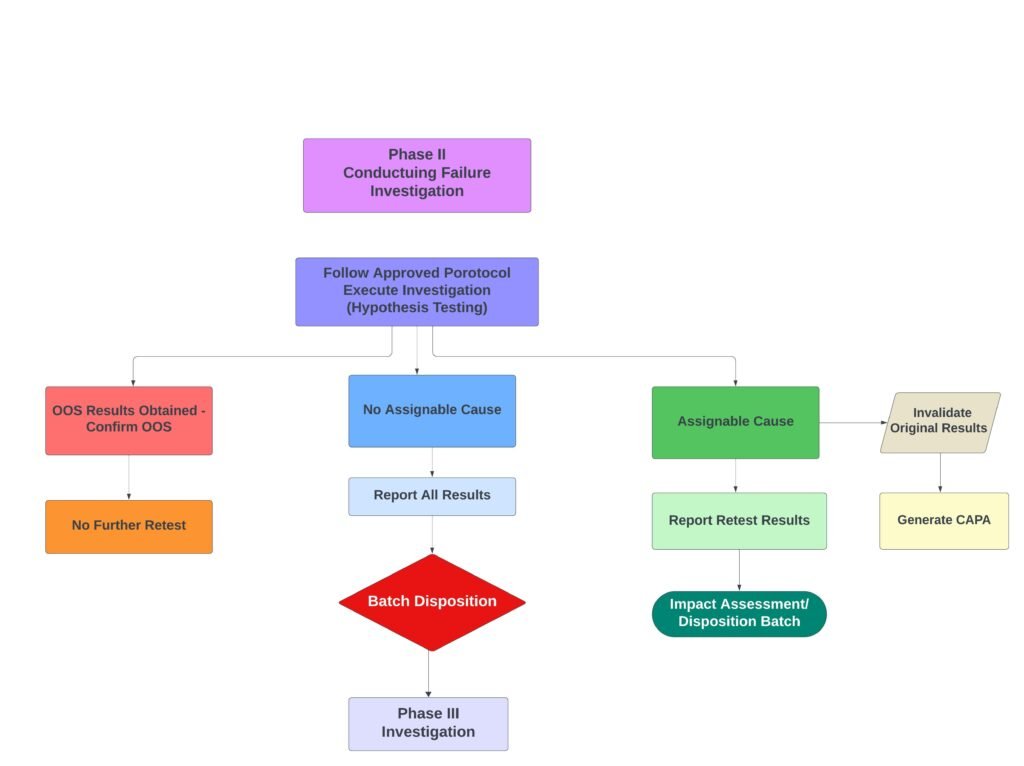
The Phase II investigation involves following approved protocols and executing investigative testing to explore possible root causes. Manufacturing investigations could also be initiated at this stage to identify any potential manufacturing-related causes. It is important to develop a hypothesis consisting of a predefined retesting plan that involves a second analyst, if possible. The investigation should document all hypothesis tests and record all obtained results.
It is very important to highlight that in Phase II of the OOS investigation, the primary intent of any retests that are being planned in the hypothesis is to confirm the hypothesis and not to replace any OOS results which occurred in the first place.
Resampling in Phase II of OOS Investigation
Based on the case, a hypothesis will often require no additional sample preparation or new product sampling to be performed. There must be a specific reason when new product sampling is required, and it can be because
- Hypothesis retesting requires extensive sample preparation and the initial sample quantity is insufficient for the retesting
- There are strong implications that the initial OOS result is due to incorrect sampling
Every attempt to initiate resampling during an OOS investigation, needs to have a logic reasoning behind it and needs to be approved from the QA team.
Unknown Cause: Hypothesis Testing and Retesting
In cases where no assignable cause or evidence of error is identified, hypothesis testing becomes crucial. Hypothesis testing involves exploring possible root causes and conducting further testing to confirm or discount these hypotheses. Retesting, which involves performing the test again using the original sample or a new sample, may also be necessary. The decision to retest should be based on sound scientific judgment, and the number of retests should be statistically valid. It is recommended to involve a different analyst for the retests to ensure objectivity.
If retest results from the initial hypothesis identify the root cause, usually, the safest way to continue is to confirm the root cause with another independent retest. In that case, the initial OOS results are annulled, and the average of the results from the initial hypothesis retesting and the results from the confirmation of the root cause can be used as the final results for the testing.
If all hypothesis attempts in Phase II of the OOS investigation fail to identify and confirm the root cause, the investigation will enter Phase III and will probably require special attention from a Subject Matter Experts (SME) group.
Key Aspects of Phase II
- Complete Hypothesis: In Phase II the most crucial aspect is having a comprehensive hypothesis design and following the plan
- Initial Hypothesis results should not replace the OOS result: Hypothesis results can only identify the root cause.
- QA approval for resampling: QA should approve product resampling during OOS investigation only if supported by strong reasoning
Phase III Investigation: Assessing Batch Quality and Disposition
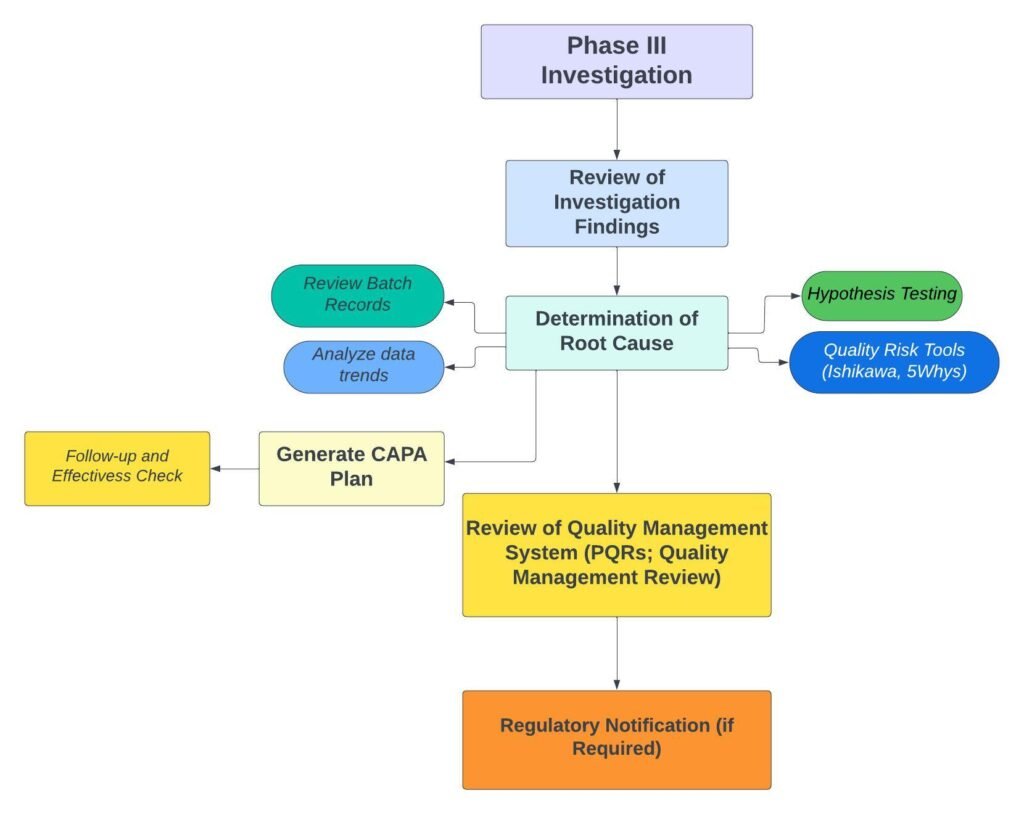
Even if a batch is rejected, a Phase III investigation must be conducted to determine if other batches or products are affected. The Phase III investigation reviews the completed manufacturing investigation and combined laboratory investigation, and assessing the results obtained. Quality Control and Quality Assurance should evaluate the impact of OOS results on other batches, ongoing stability studies, and validated processes and testing procedures. The investigation report should contain a summary of the investigations performed, a detailed conclusion, and appropriate corrective and preventive actions.
Batch Disposition: Reaching a Final Decision
During the batch disposition process, it is important to consider all test results, both passing and suspect. Invalidating initial OOS results in favor of passing retest results is not scientifically justified. The decision to release or reject a batch should be based on a thorough investigation and an evaluation of the batch’s quality. In cases where an OOS result is confirmed to be caused by a factor affecting batch quality, the batch should be rejected. All decisions and actions taken during the investigation must be fully documented, and caution should be exercised when releasing batches.
Microbiological OOS Investigations: Dealing with Unique Challenges
Microbiological investigations pose unique challenges due to the time lag between analysis and the emergence of results. To ensure accurate investigations, it is important to carefully evaluate test conditions and determine the boundaries of samples, products, and manufacturing areas. Reviewing media preparation, equipment and utilities validation, and maintenance are essential aspects of microbiological investigations. Unusual events, sample integrity, and potential sources of contamination should also be considered. Collaboration with the manufacturing team can provide valuable insights, and documentation of deviations and engineering notifications is essential.
Common Causes of OOS Results
Out of Specification (OOS) results in the pharmaceutical industry can arise from a variety of sources related to testing procedures, manufacturing processes, or human error. Identifying the root cause of OOS results is critical for implementing effective corrective actions and preventing recurrence. Some common causes of OOS results include:
Analytical Errors
OOS results can occur due to errors in the analytical testing process. This could include:
- Instrumentation issues: Malfunction or improper calibration of laboratory instruments can lead to inaccurate readings.
- Methodological flaws: Inadequate validation or incorrect implementation of analytical methods can produce erroneous results.
- Reagent and standard issues: Use of expired or contaminated reagents and incorrect preparation of standards.
- Sample mishandling: Improper sample collection, storage, or preparation can compromise test results.
Pro Tip: Regularly calibrate and maintain laboratory instruments, validate analytical methods rigorously, and ensure reagents and standards are stored and handled according to specifications. Implement robust training programs for laboratory personnel to minimize human-related errors in sample handling and analysis.
Environmental Factors
Environmental conditions, such as temperature, humidity, and lighting, can impact the stability and quality of products. Deviations from the specified environmental conditions can lead to OOS results. This could include:
- Storage and handling conditions: Inappropriate storage or handling conditions leading to degradation or contamination of the product or samples.
- Laboratory environment: Poor laboratory conditions, such as incorrect temperature or humidity, that can affect test outcomes.
Pro Tip: Monitor environmental conditions in storage areas and laboratories continuously using environmental control systems and alarms to ensure they remain within specified limits. Train staff on the importance of maintaining optimal conditions for product and sample integrity.
Manufacturing Deviations
OOS results can arise from deviations in the manufacturing process, such as incorrect formulation, improper mixing, or inadequate quality control during production. This could include:
- Raw material variability: Variations in the quality or characteristics of raw materials used in manufacturing.
- Process parameters: Deviations from established manufacturing processes, such as incorrect temperature, mixing times, or pH levels.
- Equipment malfunction: Failure or improper maintenance of manufacturing equipment leading to process inconsistencies.
- Cross-contamination: Contamination of the product from other products, materials, or environments during the manufacturing process.
Pro Tip: Monitor and control manufacturing process parameters closely using process analytical technology (PAT) and implement a robust quality management system (QMS) to ensure consistency. Regularly inspect and maintain equipment to prevent malfunctions, and strictly adhere to procedures to avoid cross-contamination.
SEE MORE: Contamination, Cross-Contamination and Mix-Ups
Raw Material Quality
OOS results can be caused by the use of substandard or contaminated raw materials. Organizations should establish stringent supplier qualification processes and conduct regular testing and evaluation of raw materials to ensure their quality and suitability for use.
- Supplier quality issues: Deficiencies in the quality of materials supplied for manufacturing or testing.
- Storage life: Exceeding shelf life or stability of the product or raw materials affecting the quality.
Pro Tip: Establish a stringent supplier qualification program to ensure only high-quality materials are used. Regularly review and test raw materials upon receipt and before use in manufacturing processes. Implement a first-expiry-first-out (FEFO) system to manage inventory and avoid using materials past their shelf life.
Stability Issues
OOS results can occur when products fail to meet the required stability criteria. Factors such as improper storage conditions, inadequate packaging, or formulation issues can impact the stability of products over time. Organizations should conduct rigorous stability testing to identify potential stability issues and take appropriate measures to address them.
Pro Tip: Implement rigorous stability testing protocols as part of the product development and quality assurance processes. Store APIs and finished products under conditions validated to maintain their stability throughout their shelf life. Utilize stability-indicating methods that are capable of detecting changes in product quality over time, and closely monitor products under real-time and accelerated stability conditions to anticipate and mitigate potential stability issues before they lead to OOS results.
SEE ALSO: Stability Storage Conditions in Pharma Industry
Impact of OOS Results on Product Safety and Efficacy
Out of Specification (OOS) results can have significant impacts on the safety and efficacy of pharmaceutical products. Understanding these impacts is crucial for manufacturers, regulatory bodies, and healthcare professionals to ensure that all medications available to patients are both safe and effective. Here’s an analysis of how OOS results can affect product safety and efficacy:
Impact on Product Safety
- Potential for Harmful Effects: OOS results might indicate that a product contains impurities or degradation products at levels higher than acceptable limits, potentially leading to adverse effects or toxic reactions in patients.
- Dosage Variability: If an OOS result indicates that the active pharmaceutical ingredient (API) concentration is outside the specified range, it can lead to under-dosing or overdosing when administered, posing significant safety risks, especially for medications with narrow therapeutic windows.
- Compromised Stability: Stability-related OOS results may suggest that a product will not maintain its intended safety profile throughout its shelf life, leading to the risk of using a product that has degraded to form harmful by-products.
Impact on Product Efficacy
- Reduced Therapeutic Effect: An OOS result indicating lower than expected levels of the API can result in reduced efficacy of the medication, leading to suboptimal treatment outcomes and potentially causing disease progression.
- Variability in Drug Release: OOS results related to the drug release characteristics (for extended-release formulations, for instance) can lead to erratic or unpredictable therapeutic levels, impacting the drug’s effectiveness.
- Influence on Bioavailability: Stability issues or inconsistencies in the formulation affecting the dissolution or absorption of the medication can lead to variations in bioavailability, impacting the drug’s therapeutic effect.
Broader Implications
- Regulatory and Compliance Issues: OOS results can lead to regulatory actions, including product recalls, warning letters, or even sanctions against manufacturers, affecting the supply chain and availability of medications.
- Consumer Confidence: Frequent OOS findings and resulting recalls can erode public trust in a manufacturer’s products and, more broadly, in the pharmaceutical industry.
- Economic Impact: The costs associated with investigating OOS results, implementing CAPAs, and potential loss of revenue from product recalls or destroyed batches can be substantial for manufacturers.
FAQ
What is the Difference Between OOS and Out of Trend (OOT) Results?
OOS results deviate from the predefined specifications, while Out of Trend (OOT) results fall within specifications but show an unexpected trend that could indicate a potential future deviation. Both require investigation to ensure product quality.
RELATED: OOS vs OOT vs OOE
How Can OOS Results be Prevented?
While it may not be possible to prevent all OOS results, the likelihood can be significantly reduced through robust quality control systems, regular equipment maintenance, thorough training of personnel, and continuous process improvement efforts.
How Important is Documentation in OOS Investigations?
Documentation is critical in OOS investigations. It provides a detailed record of the investigation, findings, actions taken, and the rationale for decisions made, ensuring transparency and accountability. Proper documentation is essential for regulatory compliance and for future reference.
Conclusion
Addressing Out of Specification results in the pharmaceutical industry requires a detailed and methodical approach. When tests reveal that a product doesn’t meet established quality standards, it’s not enough to simply rerun the test; it necessitates a deep dive into the potential reasons behind the discrepancy. This could range from procedural errors in the lab to issues in the manufacturing process. Regulatory guidelines from authorities like the FDA and MHRA outline a clear path for investigating these issues, starting with an immediate review for simple errors and, if necessary, moving on to a comprehensive investigation involving a broader team.
This process isn’t just about compliance; it’s about cultivating a culture where quality is everyone’s business. From the lab technician to the quality control manager, everyone plays a part in identifying and addressing issues. The aim is not only to pinpoint what went wrong but also to ensure it doesn’t happen again. In this context, strict regulatory standards are more than just rules to follow; they’re a framework for ensuring that every product that makes it to market is safe and effective. So, tackling OOS results is crucial—it’s about ensuring the integrity and reliability of pharmaceuticals.








